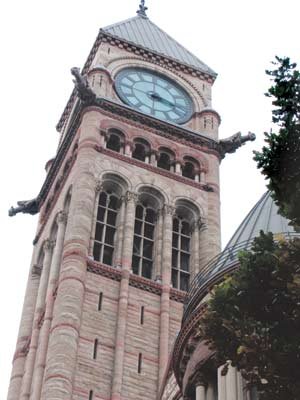
Rating: NNNNN
1. Dominion Bank Building, 1 King West (1914) The ornate, high Victorian stylings of the old Nag’s Head Tavern and former Mitchie and Co. buildings were supposed to be incorporated into this hotel condo project. It was in fact taken apart and stored — only neither the developer nor the city knows where. What remains is a corner of the Dominion bank tower, its beaux arts accents and Renaissance revival detailings largely dwarfed by the 51-storey King West Suites Hotel.
2. Commercial Bank Building, BCE Place (1845)
The Commercial Bank of the Midland District, built of Ohio sandstone, was moved here from its original site on Wellington, to make way for — wait for it — a parking garage entrance. Here, under the hermetically sealed BCE dome, one of the best examples of Greek revival in the city is overwhelmed and entombed as if in a mausoleum. People don’t pay attention to it.

3. Athenaeum Club, 167 Church (1891)
The intricate brickwork and arched windows of this former temple of the city’s labour movement offer a rare example of Moorish revival architecture. The crime here is that the city failed to designate and save the interior hallway and gallery.

4. Millichamp’s Building, 39 Adelaide East (1874)
A shadow of its former self, the exterior of this Victorian wonder of buffed brick was covered in white paint to make it match the terracotta of the building next door. Criminal.

5. Applegath Building, 85 Yonge (1914)
The city asked the developer to mimic the 19th-century windows and preserve the facade of the original. But they pushed a walkway through where the building should be. The city tossed in some public art — the courtyard behind the building is filled with sculptures. Problem is it’s not visible from the street.

6. John Kay/Wood Gundy building, 11 Adelaide West (1898)
This glazed cream-and-blush-coloured example of high Renaissance Italian design was cut into blocks, numbered and shipped off to sit in a warehouse in Scarborough, only to become an afterthought — tacked onto the back of the Scotia tower on Adelaide, adjacent to the underground parking entrance.

7. Toronto Stock Exchange, 234 Bay Street (1937)
One of the city’s most recognizable art deco landmarks, the former home of the TSE, which features a sculpted frieze, is leapfrogged here by Ernst and Young’s ugly black box, just so the developer could maximize density.

8. Fairweather Building, 100 Yonge (1867)
It’s a modern architectural tragedy that only the front skin and plate glass remains of this smooth and polished classic, one of the most sophisticated commercial buildings of its generation.












